NEFF S52E50X1GB/01 Use Instruction
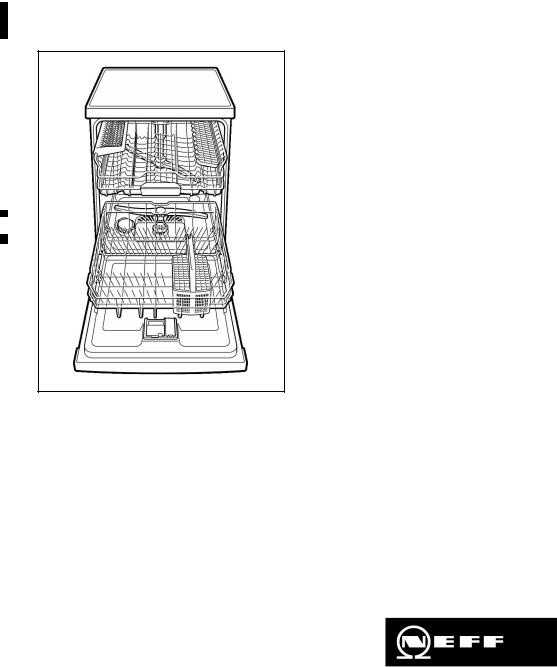
Gebrauchsanweisung
Gebrauchsanweisung
9000 405 899 (8812-1)
en Operating instructions
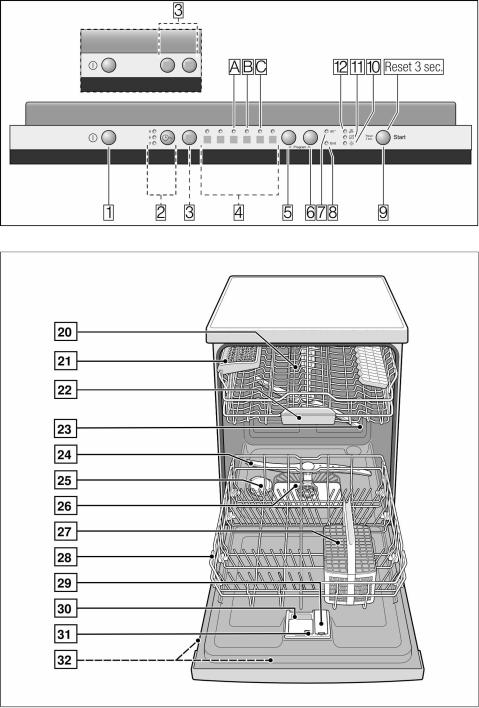

en Index
Safety instructions . . . . . . . |
4 |
Delivery . . . . . . . . . . . . . . . . . . . . |
4 |
Installation . . . . . . . . . . . . . . . . . |
4 |
In daily use . . . . . . . . . . . . . . . . . |
4 |
Children in the household . . . . |
4 |
Childproof lock (door lock) . . . . |
4 |
Damage . . . . . . . . . . . . . . . . . . . |
4 |
Disposal . . . . . . . . . . . . . . . . . . . |
5 |
Getting to know your appliance |
5 |
Control panel . . . . . . . . . . . . . . . |
5 |
Appliance interior . . . . . . . . . . . . |
5 |
Water softening system . . . |
6 |
Set . . . . . . . . . . . . . . . . . . . . . . . . |
6 |
Water hardness table . . . . . . . . |
6 |
Salt . . . . . . . . . . . . . . . . . . . . . |
7 |
Hygiene . . . . . . . . . . . . . . . . . . . . |
15 |
IntensiveZone . . . . . . . . . . . . . . |
15 |
Extra drying . . . . . . . . . . . . . . . . |
15 |
Washing the dishes . . . . . . . |
15 |
Programme data . . . . . . . . . . . . |
15 |
Aqua sensor . . . . . . . . . . . . . . . . |
15 |
Switching on the appliance . . . |
15 |
Timer programming . . . . . . . . . . |
16 |
End of programme . . . . . . . . . . . |
16 |
Switching off the appliance . . . |
16 |
Interrupting the programme . . . |
16 |
Terminating the programme (Reset) |
17 |
Changing the programme . . . . |
17 |
Intensive drying . . . . . . . . . . . . . |
17 |
Maintenance and care . . . . |
17 |
Using salt . . . . . . . . . . . . . . . . . .
Switching off salt refill indicator/ water softening system . . . . . . .
Rinse aid . . . . . . . . . . . . . . . .
Setting amount of rinse-aid . . .
Switching off rinse-aid refill indicator
Utensils . . . . . . . . . . . . . . . . .
Not suitable . . . . . . . . . . . . . . . .
Glass and utensil damage . . . .
Loading the dishwasher . . . . . .
Unloading the dishwasher . . . .
Cups and glasses . . . . . . . . . . .
Pans . . . . . . . . . . . . . . . . . . . . . .
Cutlery basket . . . . . . . . . . . . . .
Folding spikes . . . . . . . . . . . . . .
Small accessories holder . . . . .
Knife shelf . . . . . . . . . . . . . . . . . .
Adjusting the height of the basket
Detergent . . . . . . . . . . . . . . . .
Adding detergent . . . . . . . . . . . .
Overview of programmes . .
7 |
Overall condition of the machine |
17 |
|
7 |
Filters . . . . . . . . . . . . . . . . . . . . . |
18 |
|
Spray arms |
18 |
||
8 |
|||
Waste water pump |
19 |
||
8 |
|||
Troubleshooting |
19 |
||
8 |
|||
... when the appliance is switched on |
19 |
||
9 |
|||
... on the appliance |
19 |
||
9 |
|||
... during the wash cycle |
20 |
||
9 |
|||
... on the utensils |
21 |
||
9 |
|||
Customer service |
22 |
||
9 |
|||
Installation |
22 |
||
9 |
|||
Safety instructions |
22 |
||
10 |
|||
Delivery |
23 |
||
10 |
|||
Installation |
23 |
||
10 |
|||
Waste-water connection |
23 |
||
10 |
|||
Fresh-water connection |
23 |
||
11 |
|||
Electrical connection |
24 |
||
11 |
|||
Removing the appliance |
24 |
||
12 |
|||
Transportation |
24 |
||
13 |
|||
Protection against frost |
24 |
||
14 |
|||
Waste disposal |
25 |
||
|
Programme selection . . . . . . . . |
14 |
Packaging |
25 |
|
Information about comparability tests |
14 |
|||
Old appliances |
25 |
|||
Additional options |
15 |
|||
|
|
|||
Express Wash (VarioSpeed) . . |
15 |
|
|
|
Half load . . . . . . . . . . . . . . . . . . . |
15 |
|
|

en
Safety instructions
Delivery
Check the packaging and dishwasher immediately for damage caused in transit. Do not switch on a damaged appliance, but contact your supplier. Please dispose of the packaging material in an environmentally friendly manner.
Do not let children play with packaging and its parts. There is a risk of suffocation from collapsible boxes and film.
Installation
Read the “Installation” chapter to learn how to install and connect the appliance correctly.
In daily use
Use the dishwasher only in the household and only for its designed purpose, i.e. for washing domestic dishes.
Do not lean or sit on the open door. The appliance could tip.
Please note that free-standing appliances may tip over if the baskets are overloaded.
Do not add any solvents to the washing chamber. Danger of explosion!
Open the door carefully when the programme is still running. There is a risk of hot water spraying out of the appliance.
To prevent injuries, e.g. caused by stumbling, open the dishwasher only briefly in order to load and unload the dishwasher.
Read and observe the safety information and instructions for use on the packaging for cleaning and rinsing agents.
Warning
Knives and other utensils with sharp points must be placed in the cutlery basket with the points downwards or horizontally on the knife shelf *.
* depending on model
Children in the household
If fitted, use the childproof lock. An exact description can be found in the back of the envelope.
Do not allow children to play with or operate the appliance.
Keep children away from detergents and rinse aid. These may cause chemical burns in the mouth, throat and eyes or asphyxiation.
Keep children away from open dishwasher. The water in the rinsing compartment is not drinking water and could contain detergent residue. Ensure that children do not place fingers in the tablet collecting tray 22 . Small fingers could become caught in the slots.
If the appliance is installed at eye-level, ensure when opening and closing the door that children are not caught or crushed between the appliance door and the cupboard door situated below.
Childproof lock (door lock)
The description of the childproof lock is at the back in the envelope.
Damage
The appliance may be repaired and opened up by a technician only. To do this, disconnect the appliance from the power supply. Pull out the mains plug or switch off the fuse. Turn off the tap.
4
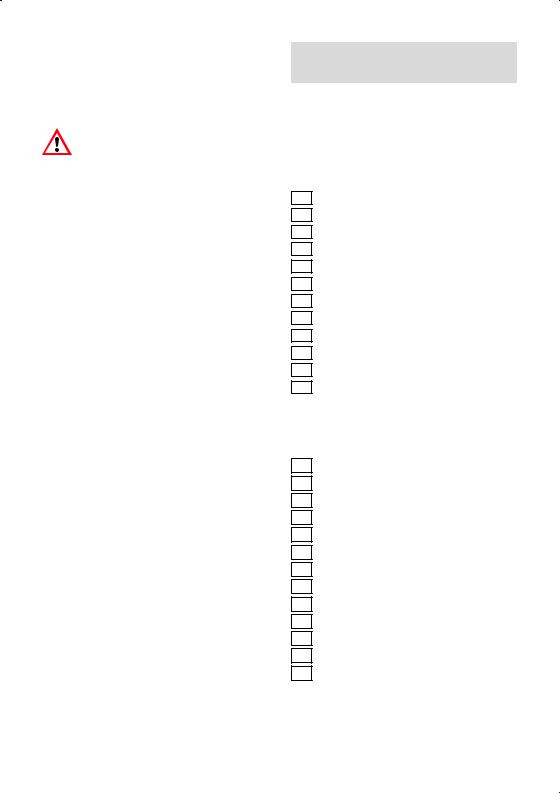
Disposal
 Make redundant appliances unusable to prevent subsequent accidents.
Make redundant appliances unusable to prevent subsequent accidents.  Dispose of the appliance in an environmentally friendly manner.
Dispose of the appliance in an environmentally friendly manner.
Warning
Children could become locked in the appliance (risk of suffocation) or find themselves in other dangerous situations. Therefore: Pull out the mains plug, sever and dispose of the power cord. Destroy the door lock so that the door can no longer be closed.
en
Getting to know your appliance
Diagrams of the control panel and the interior of the appliance can be found in the envelope at the front.
Individual positions are referred to in the text.
Control panel
1ON/OFF switch
2Timer programming *
3Additional options **
4Programme **
5Button <
6Button >
7Cleaning display
8End display
9START button
10Rinse-aid refill indicator
11Salt refill indicator
12Display “Check water supply”
*depending on model
**Number depending on model
Appliance interior
20Top basket
21Knife shelf *
22Tablet collecting tray
23Top spray arm
24Bottom spray arm
25Dispenser for salt
26Filters
27Cutlery basket
28Bottom basket
29Dispenser for rinse aid
30Detergent dispenser
31Lock for detergent dispenser
32Rating plate
*depending on model
5

en
Water softening system
To ensure good washing results, the dishwasher requires soft water, i.e. containing low amounts of lime, otherwise white limescale will be deposited on the utensils and inner container.
Tap water above a specific degree of water hardness must be softened, i.e. descaled, for use in a dishwasher.
Water is softened with special salt in the water softening system of the dishwasher. The setting and therefore the required amount of salt depends on the degree
of hardness of your tap water (see table).
Set
The amount of salt dispensed can be set in 4 stages depending on the hardness of your water. Accordingly 0, 1, 2 or
3 displays are lit (see table). Factory setting: 1.
Find out about the hardness value of your tap water. Your water supply
company or customer service will assist you.
Setting can be found in the water hardness table.
|
Open the door. |
|
|
|
|
|
|
|
|
|
|
|
|
||||||||
|
Switch on ON/OFF switch |
|
|
. |
|||||||||||||||||
|
1 |
||||||||||||||||||||
|
Hold down button > |
|
|
|
|
|
|
and press |
|||||||||||||
|
6 |
|
|
||||||||||||||||||
|
Start button |
|
|
|
until the End display |
||||||||||||||||
9 |
|||||||||||||||||||||
|
|
and salt refill indicator |
|
flash. |
|||||||||||||||||
|
8 |
11 |
|||||||||||||||||||
|
Release buttons. |
|
|
|
|
|
|
|
|
|
|
|
|
||||||||
|
The salt refill indicator |
|
|
|
|
|
flashes and |
||||||||||||||
|
|
11 |
|
|
|||||||||||||||||
|
the displays |
|
|
|
are lit (= setting 1). |
||||||||||||||||
|
|
A |
|||||||||||||||||||
Change the setting as follows: |
|
|
|
||||||||||||||||||
|
Button < |
|
|
|
press until the required |
||||||||||||||||
|
|
5 |
|
||||||||||||||||||
|
setting has been selected. |
|
|
|
|||||||||||||||||
|
Press Start button |
|
|
|
. |
|
|
|
|
|
|
||||||||||
|
|
9 |
|
|
|
|
|
|
|
||||||||||||
|
The End display |
|
|
|
and salt refill |
||||||||||||||||
|
8 |
|
|
||||||||||||||||||
|
indicator |
|
|
|
go out. |
|
|
|
|
|
|
|
|
||||||||
|
|
11 |
|
|
|
|
|
|
|
|
|
||||||||||
The selected setting is saved.
Close the door.
Water hardness table
|
Hardness |
mmol/l |
Setting |
A |
B |
C |
_Clarke |
range |
|||||
0–8 |
soft |
0–1,1 |
0 |
|
|
|
9–20 |
medium |
1,2–2,9 |
1 |
|
|
|
21–26 |
hard |
3,0–3,7 |
2 |
|
|
|
27–44 |
hard |
3,8–6,2 |
3 |
|
|
|
6
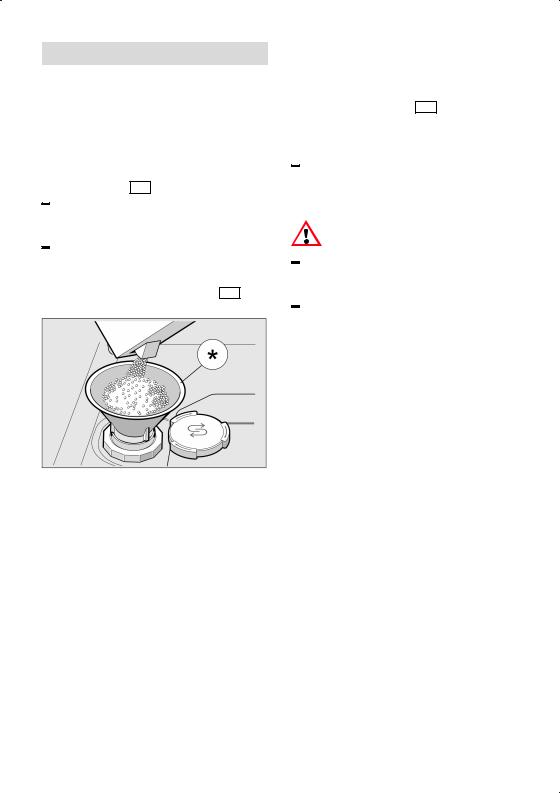
Salt
Using salt
Always refill with salt immediately before switching on the appliance. This ensures that overrun salt solution is immediately washed out and does not corrode the rinsing tank.
 Open the screw-type cap of the compartment 25 .
Open the screw-type cap of the compartment 25 .
Fill the tank with water (only required when switching on the appliance for the first time).
Then add dishwasher salt (not table salt or tablets).
The water is displaced and runs out. As soon as the salt refill indicator 11 on the fascia is lit, top up the salt.
* depending on model
Using detergents with salt component
If combined detergents with a salt component are used, salt can usually be omitted up to a water hardness of 21° dH (37° fH, 26° Clarke, 3.7 mmol/l). If the water hardness is over 21° dH, salt must be used.
en
Switching off salt refill indicator/water softening system
If the salt refill indicator 11 is impaired (e.g. when using combined detergents containing salt component), it can be switched off.
Proceed as described under “Setting” and set the value to 0.
The water softening system and salt refill indicator are now switched off.
Warnings
Never fill the salt dispenser with detergent. You will destroy the water softening system.
To prevent corrosion, always refill with salt immediately before switching on the appliance.
7
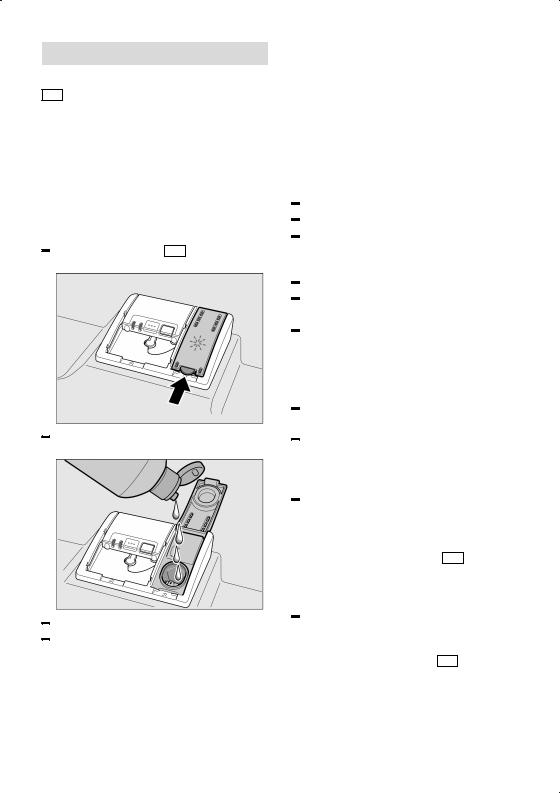
en
Rinse aid
As soon as the rinse-aid refill indicator 10 lights up on the control panel,
refill with rinse aid.
The rinse aid is required for stain-free utensils and clear glasses.
Use only rinse aid for domestic dishwashers.
Combined detergents with rinse-aid component may be used up to a water hardness of 21 _dH (37 _fH, 26 _Clarke,
3,7 mmol/l) only. If the water hardness is over 21 _dH, rinse-aid must be used.
Open the dispenser 29 by pressing and lifting the plate on the cover.
Carefully pour rinse aid up to the max. mark in the filler opening.
Close cover until it clicks shut.
To prevent excessive foam formation during the next rinse cycle, remove any rinse aid which has run over with a cloth.
Setting amount of rinse-aid
The amount of rinse aid dispensed can be set in 4 stages. Accordingly 0, 1, 2 or 3 displays are lit.
(see water hardness table). Factory setting: 2.
Do not change the amount of rinse-aid unless streaks (select lower setting) or water stains (select higher setting) are left on the utensils.
|
Open the door. |
|
|
|
|
|
|
|
|
|
|
|
|
|
|
|
|
|
|
|||||
|
Switch on ON/OFF switch |
|
|
|
|
|
. |
|
||||||||||||||||
|
|
1 |
||||||||||||||||||||||
|
Hold down button > |
|
|
|
|
|
and press |
|||||||||||||||||
6 |
|
|
|
|||||||||||||||||||||
|
Start button |
|
|
|
|
until the End display |
||||||||||||||||||
|
9 |
|
||||||||||||||||||||||
|
|
and salt refill indicator |
|
|
|
|
|
flash. |
||||||||||||||||
|
8 |
|
11 |
|
||||||||||||||||||||
|
Release buttons. |
|
|
|
|
|
|
|
|
|
|
|
|
|
|
|||||||||
|
Keep pressing button > |
|
|
|
|
|
|
|
until the |
|||||||||||||||
|
|
6 |
|
|
|
|
|
|||||||||||||||||
|
rinse aid refill indicator |
|
|
|
|
|
|
flashes. |
||||||||||||||||
|
|
10 |
|
|
|
|
||||||||||||||||||
|
Release buttons. |
|
|
|
|
|
|
|
|
|
|
|
|
|
|
|||||||||
|
The rinse-aid refill indicator |
|
|
|
flashes |
|||||||||||||||||||
|
|
10 |
||||||||||||||||||||||
|
and the displays |
|
|
|
|
|
and |
|
|
|
|
are lit (= |
||||||||||||
|
|
A |
|
|
|
B |
||||||||||||||||||
|
setting 2). |
|
|
|
|
|
|
|
|
|
|
|
|
|
|
|
|
|
|
|
|
|||
Change the setting as follows: |
|
|
|
|
|
|||||||||||||||||||
|
Press button < |
|
|
|
|
|
until the required |
|||||||||||||||||
|
|
5 |
|
|
||||||||||||||||||||
|
setting has been selected. |
|
|
|
|
|
||||||||||||||||||
|
Press Start button |
|
|
|
|
. |
|
|
|
|
|
|
|
|
|
|
||||||||
|
|
|
9 |
|
|
|
|
|
|
|
|
|
|
|||||||||||
|
The End display |
|
|
|
|
|
and rinse aid refill |
|||||||||||||||||
|
|
8 |
|
|
|
|||||||||||||||||||
|
indicator |
|
go out. |
|
|
|
|
|
|
|
|
|
||||||||||||
|
10 |
|
|
|
|
|
|
|
|
|
||||||||||||||
|
The selected setting is saved. |
|
||||||||||||||||||||||
|
Close the door. |
|
|
|
|
|
|
|
|
|
|
|
|
|
|
|
|
|
|
|||||
Switching off rinse-aid refill indicator
If the rinse-aid refill indicator 10 is
impaired (e.g. when using combined detergents containing rinse-aid component), it can be switched off.
Proceed as described under
“Setting amount of rinse aid” and select setting 0.
The rinse-aid refill indicator 10 is now switched off.
8
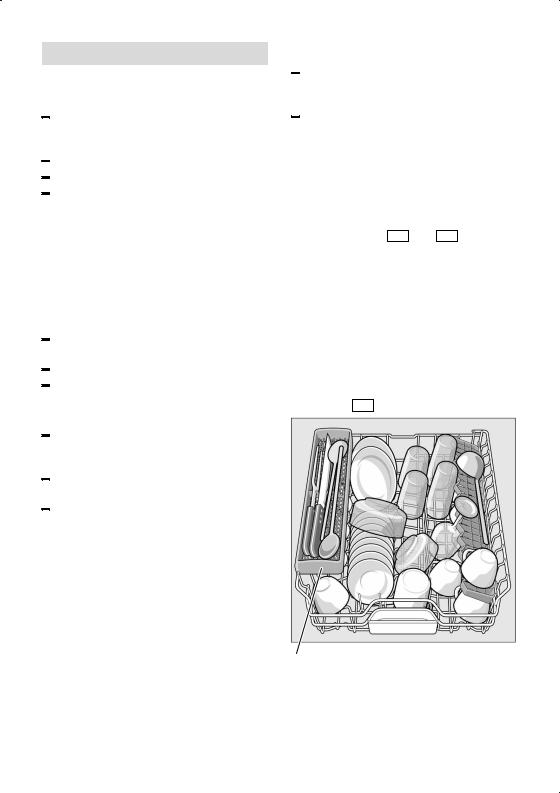
Utensils
Not suitable
 Cutlery and utensils made of wood.
Cutlery and utensils made of wood.
Delicate decorative glasses, craft and antique utensils. These decors are not dishwasher-proof.
Plastic parts not resistant to heat.
Copper and tin utensils.
Utensils which are soiled with ash, wax, lubricating grease or ink.
Aluminium and silver parts have
a tendency to discolour and fade during the wash cycle. Even some types of glass (e.g. crystal glass objects) may turn cloudy after many wash cycles.
Glass and utensil damage
Causes:
Glass type and glass production process.
Chemical composition of the detergent. Water temperature of the wash programme.
Recommendation:
Use only glasses and porcelain which the manufacturer designates as dishwasher-proof.
Use a detergent which protects utensils.
Take glass and cutlery out of the dishwasher as soon as possible after the programme ends.
en
Loading the dishwasher
Remove large food remnants.
It is not necessary to prerinse utensils under running water.
Place the utensils so that
Dthey are secure and cannot tip over.
Dall utensils with their openings face down.
Dparts with curves or indentations are at an angle, thereby allowing water to drain.
Ddoes not obstruct rotation of the two spray arms 23 and 24 .
Very small utensils should not be washed in the machine, as they may fall out of the baskets.
Unloading the dishwasher
To prevent water from dripping off the upper basket onto the utensils in the lower basket, it is recommended to empty the appliance from the bottom up.
Cups and glasses
Top basket 20
* depending on model
9
